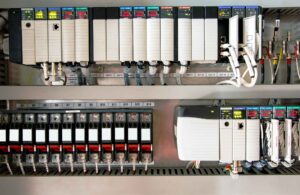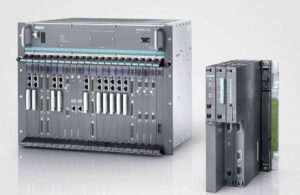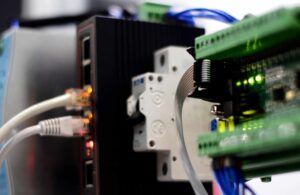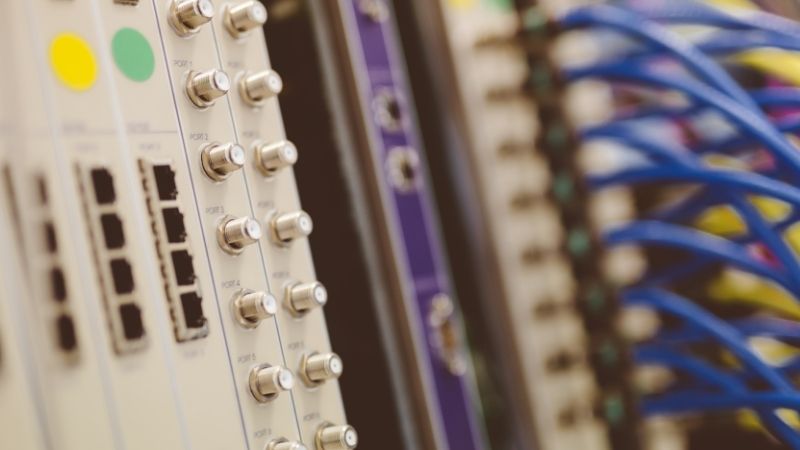O que é Ethernet/IP? Entendendo o Protocolo Industrial
Este guia abrangente explicará tudo o que você precisa saber sobre esse protocolo de comunicação vital, desde seus princípios básicos até aplicações avançadas em ambientes fabris modernos.
Índice
O que é EtherNet/IP e por que ele é importante para a automação industrial?
EtherNet/IP é um protocolo de rede que combina a tecnologia Ethernet padrão com o Common Industrial Protocol (CIP) para criar uma solução de comunicação robusta para automação industrial. Como uma implementação do CIP sobre Ethernet, ele fornece uma arquitetura de comunicação unificada em todo o ambiente industrial.
O protocolo opera em camadas de transporte TCP e UDP, tornando-o versátil para diferentes tipos de comunicações industriais. Diferentemente da Ethernet tradicional usada em ambientes de escritório, a EtherNet/IP é projetada especificamente para lidar com os requisitos exigentes das operações de chão de fábrica.
Saiba mais sobre sistemas de automação industrial e como eles se integram com redes EtherNet/IP.
Como o EtherNet/IP funciona na Internet Industrial das Coisas?
EtherNet/IP alavanca o modelo OSI e opera principalmente na camada de aplicação, enquanto utiliza infraestrutura Ethernet padrão na camada física. Este protocolo cria uma ponte perfeita entre dispositivos industriais e redes empresariais, permitindo:
- Troca de dados em tempo real entre dispositivos de automação
- Comunicação segura em todo o chão de fábrica
- Integração com redes Ethernet existentes
- Suporte para transferência de dados cíclicos e acíclicos
Descubra como os PLCs utilizam EtherNet/IP para comunicação perfeita na fabricação moderna.
Quais são os principais componentes de uma rede EtherNet/IP?
Uma rede EtherNet/IP consiste em dois tipos principais de dispositivos:
- Dispositivos de scanner
- Normalmente controladores como PLCs
- Iniciar comunicação
- Gerenciar troca de dados
- Dispositivos adaptadores
- Dispositivos e sensores de campo
- Responder a solicitações do scanner
- Entradas/saídas de controle de processo
Explore vários protocolos e redes industriais usado na fabricação.
O que torna o EtherNet/IP diferente de outros protocolos industriais?
O EtherNet/IP se destaca de outros protocolos industriais como o Modbus TCP por vários motivos:
| Recurso | Ethernet/IP | Protocolos Tradicionais |
|---|---|---|
| Velocidade | Alta velocidade (até 1 Gbps) | Frequentemente limitado a velocidades mais baixas |
| Integração | Integração perfeita de TI/OT | Capacidades de integração limitadas |
| Escalabilidade | Altamente escalável | Escalabilidade limitada |
| Segurança | Recursos avançados de segurança | Recursos básicos de segurança |
Saiba mais sobre a integração de IHM com EtherNet/IP para interfaces de operador aprimoradas.
Como implementar EtherNet/IP em sua fábrica?
A implementação de EtherNet/IP requer planejamento cuidadoso e consideração de vários fatores:
- Configuração de rede
- Esquema de endereçamento IP adequado
- Segmentação de VLAN
- Configurações de qualidade de serviço (QoS)
- Seleção de dispositivo
- CLPs e controladores compatíveis
- Dispositivos de campo suportados
- Componentes de infraestrutura de rede
Encontre os componentes de automação certos para sua rede EtherNet/IP.
Perguntas frequentes
EtherNet/IP usa CIP para gerenciar dados em tempo real por meio de mensagens implícitas e mecanismos de agendamento precisos.
Embora ambos usem a mesma camada física, o EtherNet/IP adiciona protocolos industriais e recursos de comunicação determinísticos essenciais para automação.
Sim, o EtherNet/IP pode operar junto com outros protocolos na mesma rede física por meio de segmentação de rede adequada.
EtherNet/IP inclui recursos de segurança robustos como CIP Security, mas requer a implementação adequada das melhores práticas de segurança.
Potencialize seus projetos com PLC Omron, Mitsubishi, Schneider novos e originais – em estoque, prontos agora!
Conclusão
- EtherNet/IP combina tecnologia Ethernet padrão com CIP para aplicações industriais
- O protocolo suporta dispositivos de scanner e adaptadores em redes industriais
- A implementação requer planejamento cuidadoso e configuração de rede adequada
- Segurança e confiabilidade são considerações essenciais para uma implantação bem-sucedida
- A integração com sistemas existentes é possível por meio de um projeto de rede adequado
Lembre-se de consultar profissionais de automação qualificados ao implementar EtherNet/IP em seu ambiente industrial para garantir desempenho e confiabilidade ideais.
Procurando por PLCs novos e originais para seus projetos? Na Kwoco, estocamos os PLCs mais recentes das principais marcas como Omron, Mitsubishi, e Schneider. Compre com confiança — envio rápido, qualidade garantida! Compre agora
Contate-nos
Basta preencher seu nome, endereço de e-mail e uma breve descrição de sua consulta neste formulário. Entraremos em contato com você em até 24 horas.
Você também pode achar esses tópicos interessantes

CompactLogix vs MicroLogix: Comparando PLCs Allen-Bradley
No mundo em constante evolução da automação industrial, escolher o Controlador Lógico Programável (PLC) certo é crucial para operações eficientes e confiáveis. A Allen-Bradley, uma marca da Rockwell Automation, oferece uma ampla gama de PLCs, incluindo as populares séries CompactLogix e MicroLogix. Este artigo se aprofunda em uma comparação abrangente de hardware desses PLCs, ajudando você a determinar qual controlador melhor se adapta às suas aplicações de controle.

Controlador SIMATIC da Siemens: o cérebro por trás da automação contínua
Esta postagem do blog se aprofunda no mundo dos controladores Siemens SIMATIC, explicando por que eles são uma pedra angular da automação industrial moderna e destacando seus benefícios para fábricas de máquinas e equipamentos, fabricantes e empresas de soluções de fábrica. Nosso objetivo é demonstrar como os controladores SIMATIC podem transformar suas operações, melhorar a eficiência e, finalmente, impulsionar a lucratividade. Como uma empresa especializada em automação industrial e produtos de controle industrial para plantas de manufatura, entendemos o papel crítico que os sistemas de controle confiáveis e adaptáveis desempenham no cenário competitivo de hoje.

O que é Ethernet? Por que usamos Ethernet em PLC?
Ethernet se tornou a espinha dorsal das redes locais modernas, oferecendo um meio confiável e eficiente para dispositivos se comunicarem. No reino da automação industrial, a integração da Ethernet com Controladores Lógicos Programáveis (PLCs) revolucionou a forma como os equipamentos industriais se comunicam, permitindo troca de dados mais rápida e processos de controle aprimorados.






